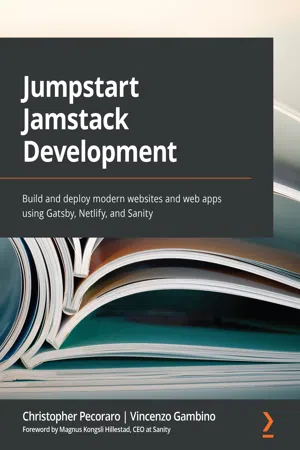
Jumpstart Jamstack Development
Build and deploy modern websites and web apps using Gatsby, Netlify, and Sanity
- 252 pages
- English
- ePUB (mobile friendly)
- Available on iOS & Android
Jumpstart Jamstack Development
Build and deploy modern websites and web apps using Gatsby, Netlify, and Sanity
About this book
Leverage Jamstack principles, techniques, and best practices to build dynamic websites and web apps focused on speed, security, and accessibility
Key Features
- Understand how JavaScript integrates with reusable application program interfaces (APIs) and browser markup to build a serverless web application
- Gain a solid understanding of static site development with Gatsby and its importance in Jamstack
- Find out how to deploy a Jamstack event website directly from GitHub using Netlify
Book Description
Jamstack (JavaScript, API, and Markup) enables web developers to create and publish modern and maintainable websites and web apps focused on speed, security, and accessibility by using tools such as Gatsby, Sanity, and Netlify. Developers working with Jamstack will be able to put their knowledge to good use with this practical guide to static site generation and content management. This Jamstack book takes a hands-on approach to implementation and related methodologies that will have you up and running with modern web development in no time.
Complete with step-by-step explanations of essential concepts, practical examples, and self-assessment questions, you'll begin by building an event and venue schema structure, and then expand the functionality, exploring all that the Jamstack has to offer. You'll learn how an example Jamstack is built, build structured content using Sanity to create a schema, use GraphQL to expose the content, and employ Gatsby to build an event website using page and template components and Tailwind CSS Framework. Lastly, you'll deploy the website to both, a Netlify server and the Microsoft Static Web Apps Service, and interact with it using Amazon Alexa.
By the end of this book, you'll have gained the knowledge and skills you need to install, configure, build, extend, and deploy a simple events website using Jamstack.
What you will learn
- Discover the Jamstack approach and build speedy, secure, and accessible websites and web apps with its component technologies
- Build an events website by using the Jamstack and the Gatsby static site generator
- Create and modify your templates and pages to build creative web apps
- Build, modify, and extend structured content schemas in Sanity
- Understand Gatsby plugins, project structure, and files, and how it can be used to build Jamstack apps
- Find out how GatsbyJS uses GraphQL to source content
Who this book is for
This book is for web developers looking to implement Jamstack practically. JavaScript developers who want to build modern speedy and secure web apps will also find this book useful. Familiarity with JavaScript and Database programming is assumed.
Frequently asked questions
- Essential is ideal for learners and professionals who enjoy exploring a wide range of subjects. Access the Essential Library with 800,000+ trusted titles and best-sellers across business, personal growth, and the humanities. Includes unlimited reading time and Standard Read Aloud voice.
- Complete: Perfect for advanced learners and researchers needing full, unrestricted access. Unlock 1.4M+ books across hundreds of subjects, including academic and specialized titles. The Complete Plan also includes advanced features like Premium Read Aloud and Research Assistant.
Please note we cannot support devices running on iOS 13 and Android 7 or earlier. Learn more about using the app.
Information
Chapter 1: History of the Jamstack
- The evolution of the Jamstack
- The rise of the Jamstack
- Our Jamstack
- Getting started with the Jamstack
The evolution of the Jamstack
HTML
Server-side includes
The Common Gateway Interface
Forms
Web page preprocessors
Content Management Systems
Table of contents
- Jumpstart Jamstack Development
- Foreword
- Preface
- Chapter 1: History of the Jamstack
- Chapter 2: Introduction to Sanity
- Chapter 3: Exploring Sanity Studio
- Chapter 4: Sanity Configuration and Schemas
- Chapter 5: Sanity's GROQ Language
- Chapter 6: Sanity's GraphQL Playground
- Chapter 7: Gatsby – An Introduction
- Chapter 8: Gatsby and GraphQL
- Chapter 9: Gatsby Source Plugins
- Chapter 10: Building Gatsby Components
- Chapter 11: APIs – Extending Gatsby
- Chapter 12: APIs – Alexa Skills
- Chapter 13: Tying It All Together
- Chapter 14: Deployment Using Netlify and Azure
- Chapter 15: Conclusion
- Other Books You May Enjoy